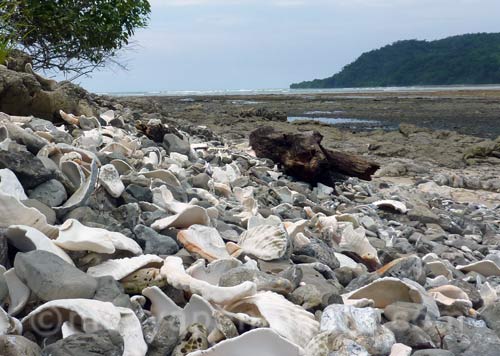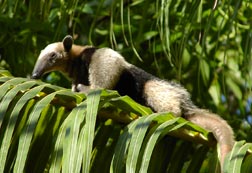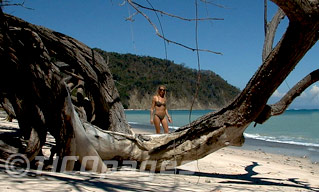Cabo Blanco Nature Reserve

Nestled on the extreme southern tip of the Nicoya Peninsula is the Cabo Blanco Nature Reserve, one of the most scenically beautiful areas of Costa Rica.
Cabo Blanco holds a special place in the history of Costa Rica. It was the country’s first area that was protected for nature conservation, and the first National Park created in Costa Rica in 1963. See The History of Cabo Blanco
The reserve is named after the island Cabo Blanco, located 1.6 km from the reserve’s southern tip. Since the times of the Conquistadores it has been known as the "White Cape" because encrusted guano covers the rocks. Cabo Blanco is an important seabird sanctuary and popular with ornithologists. It hosts large numbers of brown pelicans, frigate birds, laughing gulls, common terns, ospreys and Costa Rica’s largest community of brown boobies. See List of Birds in Mal Pais and Cabo Blanco (pdf)

Along the coast of the reserve are various roost trees to which large numbers of pelicans retire each evening. In the late afternoon from the beaches of Mal Pais and Santa Teresa you can watch them gliding past in their long V-shaped formations.
The abundance of bird life matches the wildlife found under water. 1,788 hectares of ocean belong to the Cabo Blanco nature reserve, protecting many species of fish, large quantities of lobster, giant conches and oyster.
The ocean in front of Malpais
Nature and Wildlife of Cabo Blanco:

The Cabo Blanco Nature Reserve encompasses 1,270 hectares of mixed forest which is classified as moist tropical forest. Around 150 species of trees have been identified. Evergreen species predominate, but deciduous dry forest species are found as well. Among the most common trees in Cabo Blanco are Madroño (Lance Wood), Guácimo (Bastard Cedar), Jobo (Hog Plum), Indio Desnudo (Gumbo Limbo) and Guarumo (Cecropia). The most abundant tree is the Pochote (Spiny Cedar) with some specimens that have grown over 40 m high. Other impressively tall trees are the Ceiba (Silk Cotton Tree) which can tower up to 60 m, and the fast growing Espavel (Wild Cashew). The unique climate and geographic location of Cabo Blanco also provides habitat for rare tree species like the Camibar which cannot be found anywhere else on the Nicoya Peninsula expect Cabo Blanco.

The majority of Cabo Blanco is secondary forest which is around 60 years old. The remaining patch of primary forest only accounts for roughly 15% of the area. It is located at the highest point of the reserve, inaccessible for visitors.
The forest provides refuge to a large variety of animals like white-tailed deer, pacas, armadillos, anteaters, howler and capuchin monkeys, coyotes, porcupines, raccoons and coatis. There are also wild cats like ocelots, jaguarundis and margay cats but it is almost impossible to see them in the wild.
See Animals of the Nicoya Peninsula
Around 240 species of birds have been recorded in Cabo Blanco. Apart from sea birds you can also see magpie jays, motmots, long-tailed manakins, crested caracaras, black-headed and elegant trogons, chachalacas, ringed kingfishers and various types of parrots and parakeets.
Visiting Cabo Blanco

Cabo Blanco was originally established as an "Absolute Nature Reserve" whose access was restricted to scientists and park rangers. Today visitors are allowed to hike through the reserve on two designated trails: the "Sueco" and the "Danes Trail".
You can increase your chances of seeing animals if you move slowly and silently through the trails, or sit quietly at a riverside. In dry season the visibility through the thickets is better, as many trees and shrubs shed their leaves.
The Cabo Blanco park is open from Wednesday to Sunday, 8 am – 4 pm. Entrance fee is $ 12
From Montezuma and Cabuya a small public bus drives to the park entrance four times per day. From Malpais there is no entrance to the Cabo Blanco park. You have to drive from Malpais to Cabuya
Map of Cabo Blanco

At the entrance to the nature reserve you find a booth with information about the wildlife and history of Cabo Blanco. The rangers at the station are very helpful in answering questions and there is also a tap for filling up water bottles.
If you want to hike the Sueco Trail to the Cabo Blanco beach you should arrive at the park no later than 12 am as you will need at least 4 hours for the 4.2 km to the beach and back. The trail is moderately difficult because it rises up steeply before dropping down to the beach. An easier, shorter walk is the 1.5 km loop of the Danes Trail.

The gorgeous white-sand beach of Playa Cabo Blanco lies in a half-moon bay framed by cliffs and rocky headlands. Here you can experience that Robinson Crusoe feeling and enjoy a well-deserved, luxurious bath on the pristine paradise beach.
When looking for a shady place on the beach, take care not to sit under the “Manzanilla” tree whose excretions can cause skin irritations.
Take nothing with you from the park (besides your trash of course). Even driftwood and empty shells are part of the maritime life cycle.
The history of Cabo Blanco
Costa Rica’s first Nature Reserve

In the 1950s the government of Costa Rica encouraged their citizens to "develop" the land on the isolated southern part of the Nicoya Peninsula. For clearing a piece of land, people were rewarded with its ownership. Within a few years much of the dense woodland of the peninsula had been "cultivated".
In the early sixties the Swede Nicolas Wessberg (also known as Olaf or Olle) came to Costa Rica with his Danish wife Karen Mogensen. The young couple bought a farm near Montezuma and Olaf Wessberg often went to Cabo Blanco to collect seeds for their orchard.
By this time only a small piece of primary forest was still left on Cabo Blanco. Impressed by the abundant wildlife and the enormous size and diversity of trees, Nicolas Wessberg wanted to preserve the area. With the aid of foreign conservation organizations he bought 1,250 hectares of land and after persistent talks with the Costa Rican government the status of an Absolute Nature Reserve was given to Cabo Blanco in 1963.

The Cabo Blanco Nature Reserve was the initial step in the development of Costa Rica’s extensive national park system which led to the country’s successful eco-tourism.
Sadly, in 1975 Olaf Wessberg was assassinated on the Peninsula de Osa where he supported the creation of the Corcovado National Park.
Undeterred by her husband’s death his wife Karen and many others continued with his conservation projects. Two nature reserves on the Nicoya Peninsula have been named after them: the The Karen Mogensen Nature Reserve in the mountains of the peninsula and the Nicolas Wessberg Absolute Reserve located along the beach north of Montezuma.
More about Olaf Wessberg:
• Olaf Wessberg and the Creation of Costa Rica’s first National Park (PDF)
• Pictures of Olaf Wessberg and Karen Mogensen